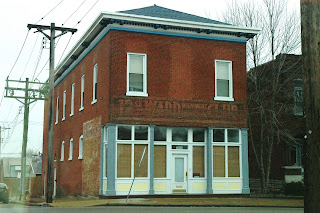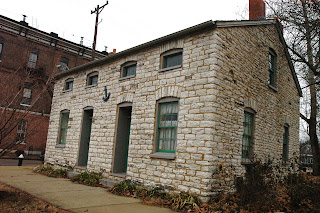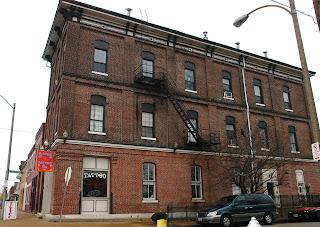First of all I always thought this area was Carondelet. Live and learn...this is Patch, the neighborhood with the coolest name of all 79. The Patch website even claims this area to be in the most southern tip of the Carondelet neighborhood. This probably stems from the fact that Carondelet was incorporated as an independent city in 1851 and was annexed by St. Louis in 1870. It's identity is much more common than Patch. I love this neighborhood. Everyone I talked to on the street and in the businesses I entered consider this place Carondelet. No one had even heard of "Patch". This may qualify it as the most under-recognized and missunderstood neighborhood in the city.
Folks, I am always a glass half-full guy when it comes to St. Louis, and this place is teeming with soul, diversity of everything, nice people, enormous potential.
Nearly everyone that saw me with my camera wanted to talk about what I was doing. Friendly, normal people. Many told me their story about how they live there and some gave me their version of the history of the buildings. I'll get to some of these stories in a moment.
People, this is an amazing old neighborhood. There is a mix of stone, frame, brick, small, medium, large, mansions, etc. You've gotta check this neck of the woods out if you haven't already.
I read of several Civil War era stone homes in Patch. Let's start with the ones I was able to find. I'm sure I missed a few but here goes:
Interesting modern addition to the stone home above. I like it.
Anywho, this is a very fun place to explore. Some would call this part of town hoosier, you've probably heard that a million times before just like I have. Maybe it is, but I like that. It's not necessarily a bad thing. It's flavorful and bold. And, I like Busch beer drinkers and kids that park their homemade go carts in the front yard. I like seeing skate boarders and tattoo artists that look legit, like they earned their tattoos, like Elliott Smith, and less like the Hot Topix suburban TV versions prevalent elsewheres. Check out that fire escape on this, one of my favorite tattoo parlors in the city!
Spoke to the owner of a building right behind Kathleen's Bar & Grill on the corner with the Bud sign. He said that building was built and operated by AB for years and his building (photo below) was the stable for the horses that brought the kegs of beer from the brewery. I was gushing over the architecture, he was proud too, he offered to sell me the building for $35K....
Here's another stable just west of here on Robert, according to the guys I spoke to it was a fire house (correction police station) from the mid-1800's:

Alright, I've digressed, back to Broadway in the Patch:

Firehouse #34, man you could do a coffee table book just on STL firehouses:

This cool market:

Hardware store, head shop (with eyes), and the delicious Broadway Bean cafe:

Speakin' as a child of the 70's, the 80's sucked and always will:
The coolest men's clothing store in town:
Goddamn I love it here.There are some beautiful churches and schools in Patch:
Carondelet Baptist Church (was this really built in 1953?), that's what it says:


The church of roller derby (St. Louis Skatium):

Lyon School:

Wanna bet?:

The striking Carondelet School of 1871, now the Grace Hill Head Start for ages 3-5:

Not unlike many other St. Louis neighborhoods, Patch took a big population hit from 1990 to 2000 losing 685 residents (19%) where 2,995 residents were counted. 86% of the people counted were white, 7% black and 4% Hispanic/Latino. That's the largest number of Hispanics I've seen so far in one neighborhood. 81% of the housing is occupied, split almost exactly 50/50 owner/rent. 895 abodes are "family households", 58% married, 36% male only raising kids, 64% female only raising kids. Patch saw ~10% population loss from 2000-2010 71% of whom were white, 21% black, 4% Hispanic/Latino and 1% Asian.
There are 3 neighborhood national historic districts listed on the Patch website. The first being Steins Steet established in 1980. The 2nd is St. Boniface established in 2002 (bound by Koeln, Tesson, Broadway and Alabama) and thirdly the Central Carondelet district establish in 2006 (Koeln, Loughborough, Broadway, Alabama) and expanded twice, once in 2007 and again in 2009.
Patch has the feel of a working class industrial neighborhood. It probably once was, and it still is to some extent, especially closest to the river where there is a lot of heavy industry.
Park space? Yes, 2 that I found:
The second I found was Fanetti Plaza, which in my opinion serves as the town center or town square. There are many restaurants, bars, bakeries, deli's, businesses I need to try. And the grand Ivory Theater.


And then there are the homes and intra-neighborhood corner buildings and businesses; quite varied as I mentioned before. I've tried to represent a cross section of what I saw:

Have a great weekend and enjoy this beautiful town we live in.































































I was assigned Carondelet as my neighborhood project back with UMSL's Honors College had an urban theme for their freshman symposium.
ReplyDeleteWe had to walk up and down the streets interviewing people about the neighborhood. It was awesome and everyone made vague references to some place called "The Patch" it was half loathing half fondness. As I was young and naive, I never even tried to figure out where the border was despite it being the very focus of what we were studying.
Excellent work here. $35,000 is a great price. You've made me thoughtful. Thank you.
I admire your project. I do hope you can get to all 79 in time. Never give up. You're doing a great job.
The Patch is a great neighborhood. A little bit of everything down there, and some of the deepest history in St. Louis. A quick correction, the stable on Robert was a police station. There was a larger building in front of it that was demolished in the 1970's.
ReplyDelete^Daron, even the bartender at Ivory Coast Cafe (in Patch) had never heard of it, and thought the neighborhood was Carondelet.
ReplyDelete^Matt, thanks for the correction. I didn't learn that through research, just picked it up from talking to some guys on the street. I will make the change, and again thanks for the accuracy check.
Wasn't this area known as Kerry Patch and populated by Irish immigrants and first generation Irish Americans? I remember my grandmother talking about this neighborhood.
ReplyDeleteWe also grew up knowing that this area was the Kerry Patch within the Carondelet neighborhood. But in typical St. Louis style, we just called it Boniface after the Parish boundary.
ReplyDeleteInteresting. The Ivory video shop was one of the first and greatest selections of videos in South St. Louis and I remember riding "way down there" to rent videos back in the day. lol There was "nothing" down there even then in the early 80s. I was amazed to see what had sprung up down there now. Awesome. I would live there.
I want the info from the guy selling that stable for $35,000. I want it. For sure. thanks for the great pics of a very unique hood in da Lou.
Most of the pictures were not in the Patch , I grew in the Patch, The skating rink was in the Patch,.The Patch was the south side of Broadway only from Catalan to the rail road tracks.most we had the ship yards, great lakes carbon,jeffers taveran, welch's store, George's store where you could run a tab lol. it was a tough place to grow up in,those who lived in the Patch know what I mean lol. what a great place looking back
ReplyDelete^"anonymous", check the map at the front of the post, it comes from the city website, the photos you see here were taken in the Patch; as I mentioned, nearly everyone thinks this is Carondelet, but I'm sticking with the city definitions.
ReplyDeleteMark:
ReplyDeleteFYI the Patch actually falls within the boundaries of the old City of Carondelet which was annexed by the City of St. Louis around the Civil War (can't remember the dates). Hence the Patch issues. Most regulars know the Patch (basically a southern version of the famous North Side Kerry Patch) was east of Broadway in that far southeastern corner of the city, and had lots of people, not just the Irish.
Go to the Carondelet branch of the St. Louis Public Library for more info.
Any NiNi Harris books will give you more color on this area.
Mark what an awesome story you have here & some great pictures. I lived in the area on Pennsylvania & Upton for about 4 yrs & have always considered this my home. Though I now live in the county I have always been known as a city girl & wouldn't change it for the world. I have some great friends from the Patch area that I still keep in contact with. I will defiantly be pointing them toward your article.
ReplyDeleteJust a note of correction for folks mistaking the "Patch" for "Kerry Patch." (from an historical archaeologist working with artifacts from that area, and having family from Kerry Patch.
ReplyDeleteKerry Patch was in North St. Louis City, and was set between Biddle and Mullanphy. It started as a tenement community at 7th, but stretched westwards over time until it reached what is now Jefferson.
Although primarily Irish-immigrants and their families lived in the area, so, too, did a lot of German/Prussian immigrants.
And, according to what was found in the archaeological record in a two block area, the term "Drunken Irishman" did not apply. The middens, where trash was thrown, had hardly any beer or liquor bottles.
My thanks to the Archaeology Research Center of St. Louis, and MODOT for allowing me access to the artifacts in my research of children in the area.
There was an Irish Catholic Church and school in the Patch, St. Columbkille, located in the 8200 block of Michigan Ave. The church and school were closed and demolished in the 1940s. The Patch did extend west of Broadway and initially included a very large Irish population. I belive there is a "Patch Center" located at 7925 Minnesota, which at one time was retail coal dealer, operated by an Irish family. As time went by, just like most City neighborhoods, the congregation of people within neighborhoods by ethnic heritage began to fade. When St. Columbkille closed, the Irish were absorbed into the German church, St. Boniface, several blocks to the north.
ReplyDeleteMy sister was baptized at St. Columbkille and I at St Boniface. My mom grew up on Reilly Ave and we lived right next door to my grandparents. Before they build the factory across the street from us, it was big open lot. Kids would play ball there. When the Admiral cruised down the river we could watch it from our front porch, and there was always a cool breeze. I didn't know I was poor until the other kids told me. Go figure.....
ReplyDeleteSt Columbkille's must have closed in late 1940's as I was born 1942 and remember the 2 churches close together. My grandparents lived east of Broadway on Marceau which was in the "Patch". . Everything was laden with black dust from the coke production furnaces to the south of Marceau. I have great memories of the Downs Amusement Park just south of the streetcar loop.
ReplyDeleteIn 1947 I attended the first grade at St. Columbkille school. We lived on Vermont Ave near Koein Ave and it seemed like a long walk to school.
ReplyDeleteThe nuns were very strict and tolerated nothing! Later when I attended public school it seemed like I was going to Disneyland with all the stuff kids got away with. Thanks for the neat photos!
St. Columbkille's opened in 1872 and closed in 1952. The church was located at 8202 Michigan Avenue and they had school in the basement.
ReplyDeleteDuring the Civil War James Eads (builder of the Eads Bridge) built ironclad gun boats for the Union at the Marine Railway Company where the River Des Peres empties into the Mississippi. St. Louis Ship is there now. One of the ironclads was called the Carondelet, another was named the St. Louis.
Carondelet was initially inhabited by French settlers, but when the Irish started moving in after the anti Irish riots in St. Louis City, in 1849, they inhabited what was to become "The Patch" which is basically the southern portion of Carondelet.
After the Irish, the Germans started moving into the area around Primm St. Then later still, the Spanish.
Great historic neighborhood!
I lived in the patch in the 4oo block of EAst Davis st. Bagsby tavern , Ulrichs Market hadits own butcher Georges store on Marceau with the pinbal machines was a place to hang out. Jeffers corner was always busy with workers from the shipyards and the Coke plant. I have a lot of good memories as akid growing up there. The Patterson family , the Lyons family , the Halter family , the Patrick family , the Tucker fanily , just a few of the good people i grew up around. It was definetely different .Memories of playing on and under the Reilly bridge. You could listen to the admiral playing. As it cruised down the river.
ReplyDelete